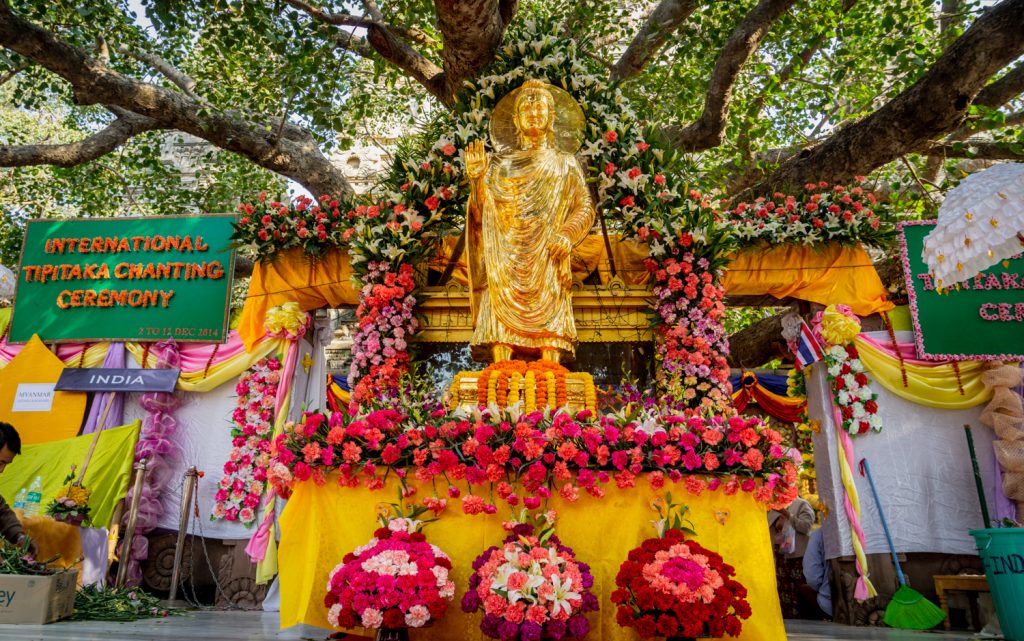Someone Who Listens
Everything and everyone are always teaching us the dharma, says Christian McEwen. We just have to know how to listen. The post Someone Who Listens appeared first on Lions Roar.

Everything and everyone are always teaching us the dharma, says Christian McEwen. We just have to know how to listen.
Milarepa (1052–1135) and Scenes from his Life (detail), Tibet, 18th century; Pigments on cloth; Rubin Museum of Art; Gift of Shelley and Donald Rubin
A bell sounded, slow and sonorous, from a nearby church. It was early in November, the maples still ablaze against a cloudless sky. Such rusty reds and flaming golds, such a delicate, pale bright blue! It was as if the chimes swirled out around each separate tree, burnished and released each leaf, caressed the grass, entranced my watching eye. Such listening is at the heart of spiritual practice, opening (if one is fortunate) into a new clarity and serenity, a deeper knowing. “When you listen with your soul, you come into rhythm and unity with the music of the universe,” wrote the Irish writer John O’Donohue.
Buddhism has numerous teachings centered on the act of listening. It’s said that when the Buddha first taught, two deer stepped softly up, knelt down beside him, and pricked up their ears. Their image can still be found in almost every Buddhist temple.
We don’t have to do anything special to have contact with the spirit world. It’s just natural if you stop and listen. Just there, always. Like your own heartbeat.
“The Buddha is always teaching,” wrote the Zen master Thich Nhat Hanh. “Times are teaching, living beings are teaching. If you have an attentive ear, you can hear the authentic dharma all the time.”
One of the most beloved texts in the Buddhist canon is the Lotus Sutra, composed in India in the first century. It describes a bodhisattva known as Wondrous Sound or Avalokiteshvara, who is dedicated to the liberation of all beings. He’s said to have been born from a ray of light sprung from Buddha’s right eye and is thus a manifestation of compassion, with the miraculous ability to address each person in his or her own language. His name, in the original Sanskrit, translates as “He Who Listens to the Cries of the World.”
The original Avalokiteshvara was always shown as male. But starting in China, around the eighth century, the figure began to be seen as female, too, in the form of Kuan Yin, or “She Who Listens to the Cries of the World.” Kuan Yin is often shown resting on a lotus, holding a willow sprig and vase of dew—the vase symbolizing the nectar of compassion, the willow representing her flexibility and strength. Her other accoutrements include an arrow, to draw friends toward her; a precious mirror, signifying wisdom; and a vajra-topped bell, with which to play the most mellifluous music. She has also been depicted with a thousand arms and hands and as an armed warrior, laden with crossbow, thunderbolt, sword, and shield. But in all her manifestations, she remains “The One Who Listens,” attentive to the sorrows of the whole lamenting world.
Christianity tends to humanize the voice of God, even when it thunders from the heavens, or seethes and crashes “like the sound of many waters.” But every so often, especially in the Celtic nature poets, we glimpse a more lyrical and capacious understanding of the sacred and of what’s worth listening to. The cosmos itself becomes audible. Once someone listens closely to the natural world, a hundred thousand voices will begin to speak.
Legend has it there was once an Irish monk named Phoenix. One day, he was reading his breviary, alone in the monastery garden, when suddenly a bird began to sing. Phoenix became utterly absorbed. When at last the song was finished, he picked up his book and went back to the monastery—only to discover he knew no one there. Centuries had passed while he sat listening in the garden. His original community was long gone, and the new monks had no idea who he was. But when they searched their annals, they discovered that many years before, a Brother Phoenix had mysteriously disappeared.
The Maidu writer Marie Mason Potts, who grew up in a cedar-bark house in northern California, remembered the sounds of her girlhood with affectionate precision: “How wonderful it was lying awake at night…to hear the coyotes bark and the hoot owls uttering their calls among the trees. Sometimes there would be the running clatter of squirrels on the bark slabs above us; and in spring and summer, just as it grew light…there came the enchantment of the bird chorus, the orchestra of the Great Spirit all around us.”
A Wintu woman of the same generation harkened back to her own childhood, describing her grandfather at his prayers. Every morning, he’d get up early, splash his face with water, and begin to pray. “He prayed to Olelbes, He-Who-Is-Above, the Wintu world creator. He also prayed directly and intimately to the things around him—to the rocks, trees, salmon, acorns, sugar pine, water, and wood.” And, “at the end of his life, he talked to the world—sharing his sadness and regret—as one might talk to an old and very trusted friend.”
That sense of equivalence, of mutuality, shows up again and again among tribal peoples, from the Chukchi reindeer herders of Siberia to the indigenous Maori of New Zealand. A member of the Pawtucket tribe put it this way, “The Indian people, we’re all this…. We’re made of this, the marshes here, the trees. No different, see what I mean? You don’t understand because you look on this world as something that is not you. But Indian people believe that we are no different from a squirrel or a bear, just a different form. We’re all the same, squirrel, bear, me.”
Or, in the words of the poet Linda Hogan, “We don’t have to do anything special to have contact with the spirit world. It’s just natural if you stop and listen. Just there, always. Like your own heartbeat.”
One of the strange gifts of the pandemic was that people had more time for this, more time to listen to both inner and outer worlds. Listening helps us to slow down and pay attention—to remember, viscerally, that we’re interdependent, intertwined. One of my models for this is the Buddhist teacher Milarepa, who sits calmly on his cushion, one hand curved around the arch of his right ear. Milarepa was a poet and musician, the first ordinary Tibetan to attain enlightenment. He could hear a snail as it oozed over the stony ground, a couple quarreling in a distant village, the most thwarted, muffled sob. Nothing was foreign to him. In the course of his long life, he became “Someone Who Listens,” alert to the joys and sorrows of the entire surrounding world.

 Tekef
Tekef 

































